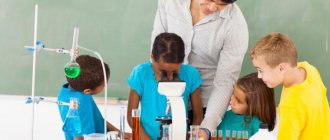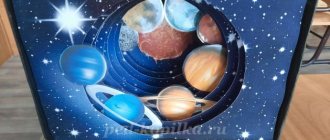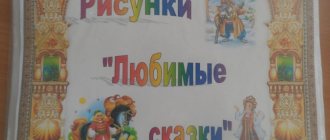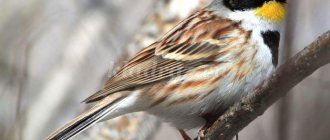Project "Fairy Tale in Music"
Relevance
The preschool period of childhood is generally recognized as the initial stage in the development of the child’s inner world, his spirituality, and the formation of universal human values.
Introducing a child to art introduces a child to a world of exciting and joyful experiences and opens up the path to the aesthetic development of life. Art is a core component of the modern preschool educational process.
Art influences the formation of a holistic, comprehensively and harmoniously developed personality, the formation of his culture, needs, interests, abilities, motivations necessary for further successful learning, development, and socialization.
Art is the most important component of spiritual culture, which includes literature, painting, and music. All these species are connected and intertwined with each other by special bonds, deeply internal, having the same basis - the diverse manifestations of nature.
In order to form a holistic picture of the world in children, it is necessary to synthesize as much as possible the types of art that allow you to “voice” and “revive” a picture, music, and awaken a whole range of feelings and associations.
Goal: Introducing children of senior preschool age to musical culture and fine arts through organizing joint artistic and creative activities of children, parents and teachers.
Tasks:
- To improve the conditions in preschool educational institutions for introducing children to musical culture and the fine arts.
- Develop and systematize work to introduce children to musical culture and fine arts through the organization of joint artistic and creative activities.
- Strengthen cooperation and interaction of preschool educational institutions with families of pupils.
- Continue to form emotional and aesthetic orientations, bring children to an understanding of the value of art, promote the development and use of various aesthetic assessments, judgments regarding the manifestations of beauty in the world around them, artistic images, and their own creative works.
Project type: long-term, creative.
Dates: from October 2013 to January 2014
Project participants:
- children of senior preschool age,
- parents of students,
- project leaders: teacher - Muravyova M.A., music director - Enoktaeva O.A.
Description of activities during the project
Basic principles:
- developmental education;
- combination of scientific validity and practical applicability;
- compliance with the criteria of completeness, necessity and sufficiency;
- ensuring the unity of educational, developmental and training goals and objectives of the education process for preschool children;
- ensuring the integration of educational areas in accordance with the age capabilities and characteristics of students, the specifics and capabilities of educational areas;
- solving program educational problems during joint activities of adults and children, in independent activities of children, within the framework of direct educational activities and in interaction with children’s families;
- building educational activities based on the individual characteristics of each child, in which the child himself becomes active in choosing the content of his education, becomes the subject of preschool education;
- assistance and cooperation of children and adults, recognition of the child as a full participant (subject) of educational relations;
- supporting children's initiative in various activities;
- formation of cognitive interests and cognitive actions of the child in various types of activities;
- age adequacy of preschool education (compliance of conditions, requirements, methods with age and developmental characteristics).
Stages of work:
1. Preparatory:
— study of scientific and methodological literature, analysis of Internet resources on this topic;
— selection of necessary materials: reproductions and musical works;
— updating the center for artistic and aesthetic activities in groups.
This project requires the active participation of parents:
— surveying parents on the topic of the project;
- meetings with parents;
— joint creation of a music library, video library;
— participation in the creation of a “mini-gallery” (paintings, portraits of the great composer, artists);
— participation in the collection of fiction on this topic (outstanding musicians, artists);
— joint meetings in the musical and creative living room.
2. Basic – practical:
During the implementation of the project with preschool children, it is planned to organize a musical and creative living room once a week
Perspective plan of a musical and creative living room in the preparatory group
Theme: "Ballet of the Unhatched Chicks"
Perception of music: M.P. Mussorgsky's "Ballet of the Unhatched Chicks".
Rhythmoplasty: M.P. Mussorgsky's "Ballet of the Unhatched Chicks".
Fiction: E. Mikhalenko “Chicken”, T. Zavadskaya “The Tale of the Chicken”.
Artistic and creative activity: “Ballet of unhatched chicks” (applique made of corrugated paper).
Multimedia presentations: “Pictures from an Exhibition” Soyuzmultfilm, 1984, “Chicken” Soyuzmultfilm, 1973.
Visual aids: Victor Gar, illustrations, reproduction of A. Kuznetsova’s painting “Kittens and Chicks.”
Theme: "Gnome"
Perception of music: M.P. Mussorgsky "Gnome".
Rhythmoplasty: M.P. Mussorgsky "Gnome".
Fiction: M. Lipskerov “The Little Dwarf Vasya”, the fairy tale of the Brothers Grimm “Snow White and the Seven Dwarfs”, T. Minchenko “The Deciduous Dwarf”.
Artistic and creative activity: “Gnome” (applique, origami).
Multimedia presentations: “The smallest gnome.” Soyuzmultfilm, 1977 -83, “Snow White and the Seven Dwarfs” (Disney), 1939, “Dwarf” https://yadi.sk/d/GtXzHemjTmrwh.
Visual aids: Victor Gar , illustrations
Topic: “Old Castle”
Perception of music: M.P. Mussorgsky "The Old Castle".
Rhythmoplasty: M.P. Mussorgsky "The Old Castle".
Fiction: Charles Perrault "Sleeping Beauty".
Artistic and creative activity: “Old Castle” (paper making, painting, appliqué).
Multimedia presentations: “Sleeping Beauty”, 1959Country: USA “Old Castle” https://yadi.sk/d/hMGe4PzETmpyu.
Visual aids: Illustrations , pictures “Castles”, reproduction of a painting by G.P. Kondratenko “Ruins of an old castle”.
Topic: “The Hut on Chicken Legs”
Perception of music: M.P. Mussorgsky "The Hut on Chicken Legs"
Rhythmoplasty: M.P. Mussorgsky "The Hut on Chicken Legs"
Fiction: Russian folk tales.
Artistic and creative activity: “Baba Yaga” (plasticineography).
Multimedia presentations: “Pictures from an Exhibition” Soyuzmultfilm, 1984 , “Ivashka from the Palace of Pioneers” Soyuzmultfilm, 1981
Visual aids: Victor Gar, illustrations, reproduction of a painting by I.I. Shishkin “Dark Forest”, I. Levitan “Birch Grove”.
Topic: “Bogatyr Gate. In the capital city of Kyiv"
Perception of music: M.P. Mussorgsky “The Bogatyr Gate. In the capital city of Kiev .
Rhythmoplasty: M.P. Mussorgsky “The Bogatyr Gate. In the capital city of Kyiv."
Fiction: Russian folk epics.
Artistic and creative activity: “Bogatyr Gate” (painting, applique).
Multimedia presentations: “Pictures from an Exhibition” Soyuzmultfilm, 1984, “Vasilisa Mikulishna” Soyuzmultfilm, 1975, “Two Heroes” Soyuzmultfilm, 1989.
Visual aids: Victor Gar, illustrations, reproductions of paintings by V.M. Vasnetsov “Three Heroes”, “The Knight at the Crossroads”.
Topic: “Limoges market”
Perception of music: M.P. Mussorgsky "Limoges Market".
Rhythmoplasty: M.P. Mussorgsky "Limoges Market".
Fiction: A. Barto “Who needs what? (At the bird market)”, E. Uspensky “Bird market”.
Artistic and creative activity: “Limoges market” (creative task for parents).
Multimedia presentations: “Bird market” TO “Ekran”, 1974, “How an old man sold a cow” TO “Ekran”, 1980, “Limoges. Market" https://yadi.sk/d/mpMjh8xsTmt2t.
Visual aids: Illustrations, reproduction of F.V. Sychkov’s painting “Collective Farm Bazaar”.
Topic: “Tuileries Garden”
Perception of music: M.P. Mussorgsky "Tuileries Garden".
Rhythmoplasty: M.P. Mussorgsky "Tuileries Garden".
Fiction: Tales about toys and children's fun.
Artistic and creative activity: “Tuileries Garden” (creative task for parents).
Multimedia presentations: “Tuileries Garden” “Pictures from an Exhibition” Soyuzmultfilm, 1984, “Tuileries” https://yadi.sk/d/AzkhZvlrTmtBy.
Visual aids: Illustrations, pictures, reproductions of paintings by K. E. Makovsky.
Topic: “Catacombs. Roman tomb"
Perception of music: M.P. Mussorgsky "Catacombs. Roman tomb."
Rhythmoplasty: M.P. Mussorgsky "Catacombs. Roman tomb."
Fiction: Myths of Ancient Rome for preschool children.
Artistic and creative activity: “Catacombs. Roman tomb" (applique).
Multimedia presentations: Presentation “Roman Tombs”.
Visual aids: Illustrations, Victor Gar.
Characteristic features of organizing a musical and creative living room to introduce children to art:
- community of arts;
- diversity of artistic and information space;
- cognition through experience, creativity;
- joint activities of adults and children;
- success, achievements, discoveries of children;
- the child's individuality as a value.
3. Final
- Exhibition of creative works of children and parents “Pictures from an Exhibition”.
- Making attributes and costumes by parents for the “Living Pictures” holiday.
- Holding a holiday for children and parents of the kindergarten “Living Pictures”.
- Presentation of the project “Fairy Tale in Music” at the pedagogical council, city conference.
Bibliography:
- N. Basina “With a brush and music in the palm” / M., 1997.
- I. Shtanko “Education with art in kindergarten” / M. 2007.
- V. Stasov “Collected articles about Mussorgsky and his works” / M., 1987.
- N. Novikov “The sound of the native string...” / Moscow AST 2006.
- M. Karotkova “Problems of musical classics” / M., 1998.
- M. Yuryev “M.P. Mussorgsky. Biography" / JSC "Prosveshchenie", 2005.
- P. Solomonov “Archive of classical music” / “Music” St. Petersburg, 2001.
- R. Petrov “Artistic trends in the musical art of the 19th century” / Moscow AST, 2006.
- E. Fried “M.P. Mussorgsky"/"Music" St. Petersburg 2003.
MAGAZINE Preschooler.RF
From birth, a child is a discoverer, an explorer of the world that surrounds him. Everything is new for him: sun and rain, fear and joy. Everyone knows that five-year-old children are called “why kids.” A child cannot find the answer to all his questions on his own; teachers help him. Currently, the project-based teaching method is widely used in preschool institutions. An approximate work plan for teachers to prepare the project.Based on the children’s problems studied, set the goal of the project. Developing a plan to achieve the goal (the teacher discusses the plan with the parents). Involvement of specialists in the implementation of relevant sections of the project. Drawing up a project plan. Collection, accumulation of material. Inclusion of classes, games and other types of children's activities in the project plan. Homework for the child and parents to complete together. Presentation of the project, open lesson.
In the process of creating musical projects, it is necessary to take into account the characteristics of the neuropsychic and musical development of children.
Let us remember that at first children only listen to (perceive) music, and on this basis they will later try to sing and dance. At this age, children intensively form the foundations of the child’s personality. Such complex moral feelings develop as love for loved ones, a kind attitude towards animals and plants, and the desire to be good and kind. Therefore, children enjoy listening to music related in content to his home: with images of his beloved mother, father, grandmother, grandfather, pets, toys, and the natural environment; musical perception continues to develop. Attention becomes more and more voluntary, so children can listen to a piece of music (short) until the end. Perceiving with pleasure the vivid concrete image of a piece of music, most children also clearly demonstrate emotional responsiveness to music. Children have a great desire to sing familiar songs and learn new ones. By imitating adults, they quite easily master drawn-out sounds and can sing short phrases (two or three words) together. They not only distinguish, but also reproduce low and high sounds of unfixed height. But due to their psychological capabilities, they cannot monitor the purity of the singing intonation, so they sing the melody mostly incorrectly. In dancing and games, younger preschoolers are able to show emotional responsiveness that is adequate to the nature of the music (cheerful or sad), and distinguish contrast in music. They can: · change movements in connection with the change of different types of music, · quite rhythmically perform such basic movements as walking, running, as well as simple dance movements, · with great pleasure independently perform movements in dances and games while an adult sings, · with joy joins in free dances, usually performing the same type of movements. · they like games and dances with a simple, specific plot; children are able to perform play roles. Children are attracted by the sound of such children's musical instruments as the pipe, drum, tambourine, metallophone, as well as the different timbre colors of homemade sounding toys. Children quite easily distinguish not only the timbre of the sound of familiar instruments, but also the dynamics of their sound (quiet and loud) and tempo features (fast and slow); he tries to reproduce them, conveys the fast tempo better. At this age, the development of instrumental improvisation is observed - they examine musical instruments with interest: they study records, buttons, etc., showing great interest in their structure and appearance, and try to improvise on them. An approximate list of project topics for early preschool age. Subject of the block
| Project name | Collaborative Product | |
| Family | "I and my family" | Making voice cards (on CDs with wishes of goodness and happiness to children every day, creating a photo album with pages about the child’s family and the text of a favorite song. |
| "Pets" | Parents' puppet shows. Entertainment “The Bug Came to Us”, “Visiting the Cat”. | |
| "Secrets of Grandma's Chest" | Creating a “magic chest” with toys (folk crafts) - whistles, pipes, nesting dolls, etc. Didactic games: “Find the same one” (sound of instruments), “Whose song” (voices of animals, sounds of nature). Exhibition of musical family heirlooms. | |
| "Mom's Lullabies" | Album of drawings and pictures with lullaby texts. Creating a music library for listening to lullabies during special moments. | |
| "I am in the human world" | 1). "My friends" 2) “In our Neskuchny Garden” 3) “Tales of Friendship” | Musical and theatrical sketches, an album of photo collages. Project “Our Holiday”. Release of a wall newspaper. Collection of children's music library with musical fairy tales. |
| "The world around us" | "Winter's Tale" "Seasons" "World of Animals and Birds" | Card index of New Year and winter songs. Replenishment of the musical zone: dance attributes: autumn leaves, rain plumes, snowflakes, flowers, etc.; card file of diagrams for modeling dance compositions; music library with seasonal music (thematic songs, classical music). Dance miniatures. Musical-figurative studies. Updating the theater area with elements of animal and bird costumes. Exhibition of drawings “Our four-legged friends”, “Winged friends”. Evening of riddles “Such different voices.” |
| "You and your health" | "Strong Kids" | Diary "I'm growing" Mini project “Morning of a Healthy Day” (meeting with Aibolit, rhythmic gymnastics) Writing fairy tales, poems, theatrical sketches. “How did fruits and vegetables argue about their benefits?” Leisure time with parents “Be healthy” (introduction to game exercises accompanied by music) |
Note to the teacher:
- Early manifestation of musical abilities indicates the need to begin the child’s musical development as early as possible.
- Don’t be upset if the child’s singing and movements are far from perfect: systematic quantitative fulfillment of indicators will certainly turn into qualitative growth.
- The absence of any of the abilities can inhibit the development of the others - which means that the adult’s task is to remove the unwanted “brake”.
- The more active a child’s communication with music is, the more musical he becomes, but do not forget to help the child understand the music he is listening to (its content, character). Give your child a “guiding thread” to empathy: help your child find in his soul and his life experience – in his memory – those feelings and experiences that he himself has already experienced and which are consonant with the nature and content of the music he is listening to.
| < Previous | Next > |




